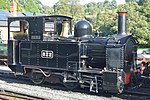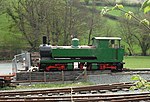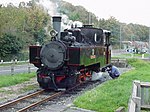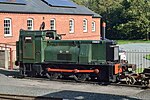Welshpool and Llanfair Light Railway
| Welshpool & Llanfair Light Railway | |
|---|---|
| Rheilffordd y Trallwng a Llanfair Caereinion | |
 823 Countess – one of the two original W&LLR engines | |
| Locale | Mid-Wales |
| Terminus | Welshpool |
| Commercial operations | |
| Name | Welshpool & Llanfair Light Railway |
| Original gauge | 2 ft 6 in (762 mm) |
| Preserved operations | |
| Length | 8.5 miles (13.7 km) |
| Preserved gauge | 2 ft 6 in (762 mm) |
| Commercial history | |
| Opened | 1903 |
| Closed to passengers | 1931 |
| Closed | 1956 |
| Preservation history | |
| 1963 | Re-opened as a heritage railway |
| 1972 | Services extended to Sylfaen |
| 1981 | Opening of extension to Raven Square |
Welshpool & Llanfair Light Railway | ||||||||||||||||||||||||||||||||||||||||||||||||||||||||||||||||||||||||||||||||||||||||||||||||||
|---|---|---|---|---|---|---|---|---|---|---|---|---|---|---|---|---|---|---|---|---|---|---|---|---|---|---|---|---|---|---|---|---|---|---|---|---|---|---|---|---|---|---|---|---|---|---|---|---|---|---|---|---|---|---|---|---|---|---|---|---|---|---|---|---|---|---|---|---|---|---|---|---|---|---|---|---|---|---|---|---|---|---|---|---|---|---|---|---|---|---|---|---|---|---|---|---|---|---|
| ||||||||||||||||||||||||||||||||||||||||||||||||||||||||||||||||||||||||||||||||||||||||||||||||||
The Welshpool & Llanfair Light Railway (W&LLR) (Welsh: Rheilffordd y Trallwng a Llanfair Caereinion) is a 2 ft 6 in (762 mm) narrow gauge heritage railway in Powys, Wales. The line is around 8.5 miles (13.7 km) long and runs westwards from the town of Welshpool (Welsh: Y Trallwng) via Castle Caereinion to the village of Llanfair Caereinion.
History
Early proposals
The first proposal to connect Llanfair Caerinion and Welshpool by railway was the Llanfair Railway of 1864; this would have been a narrow gauge line, with a mixed gauge section where it connected to the Cambrian Railways. This proposal was abandoned. The next attempt came in 1876 with the promotion of the Welshpool and Llanfair Railway Bill, which proposed a railway along a similar route to the 1864 effort. This Bill passed through the Houses of Parliament. This attempt failed in 1882 because the promoters were unable to raise sufficient capital. In 1886, another Welshpool and Llanfair Railway Bill appeared for a 3 ft (914 mm) gauge railway on a similar route; this bill expired unused in 1892.[1]
The Light Railways Act of 1896
In 1896, the Light Railways Act was passed, and this spurred further attempts at a railway to Llanfair Caereinion. The first of these was the Llanfair & Meifod Valley Light Railway bill of 1896, which proposed a standard-gauge line from Arddleen about 8 miles north of Welshpool, through the Meifod Valley.[1]
In late December 1896, the mayor of Welshpool William Addie proposed a 2 ft 6 in (762 mm) gauge railway called the Welshpool and Llanfair Light Railway. By March 1897, Addie had contracted with noted narrow gauge promoter Everard Calthrop to assist in preparing a case for the inquiry. An application for a Light Railway Order was submitted to the Board of Trade in May 1897. Calthrop proposed the use of transporter wagons, 0-6-0 tank locomotives and a large "Barsi-type" locomotive for heavy market day traffic. At the August 1897 public inquiry Calthrop appeared, along with J.R. Dix manager of the Corris Railway. The enquiry considered by the Llanfair & Meifod Light Railway and the Welshpool and Llanfair Light Railway proposals. The commissioners took their time deciding. Meanwhile, the promoters of the W&LLR had approached the Cambrian Railways to have them pay for and construct the railway. After much time-consuming negotiations, the Cambrian agreed and on 8th. September 1899, the Light Railway Order was granted to begin construction of the line.[1]
Original operations

It was opened on 4 April 1903 to aid economic development in a remote area, never making a profit. It was originally operated by the Cambrian Railways, connecting with it at the former Oswestry and Newtown Railway station in the town of Welshpool. The line is built through difficult country, having a great number of curves in order to reach the summit of 600 ft. The original terminus at Welshpool was located alongside the main line station and trains wound their way through the town, using the locomotive bell as a warning.
In the 1923 Grouping of railway companies, Cambrian Railways, including the Welshpool to Llanfair Caereinion line, was absorbed by the Great Western Railway (GWR). On 9 February 1931 the line lost its passenger service, which was replaced by a bus service, and it became a freight-only line. It was temporarily re-opened to passengers between 6 and 11 August 1945 for the Eisteddfod. The GWR itself was nationalised in 1948 and became part of British Railways.
Freight traffic lingered on until 1956, by which time British Railways decided to close the line, with services ceasing on 5 November.[2]
Preservation


A group of volunteers and enthusiasts took the line over and started raising money to restore it. On 6 April 1963 the western half of the line, from Llanfair Caereinion to Castle Caereinion, was reopened as a tourist railway. In 1972 services were extended to Sylfaen. The line through Welshpool, however, could not be reopened, so the line now has a new terminus station at Raven Square on the western outskirts of the town, opened on 18 July 1981. There are current discussions about reinstating the link through the town to the main line station, following a different route from that originally used.
Because of the 2 ft 6 in (762 mm) gauge, unusual for British narrow gauge railways, locomotives and rolling stock to supplement the originals have had to be obtained from sources around the world including the Zillertalbahn in Austria. A major grant from the Heritage Lottery Fund permitted restoration of both original locomotives together with several coaches and original wagons, and provision of new workshop facilities, ready for the line's centenary.
Locomotives
Locomotives of the preserved railway
| WLLR No. | Name | Image | Builder | Works No. | Date built | Date arrived | Wheels | Type | Status | Notes |
|---|---|---|---|---|---|---|---|---|---|---|
| 1 | The Earl | 
|
Beyer Peacock | 3496 | 1902 | 1902 | 0-6-0T | Steam | Overhaul off site | Original W&LLR locomotive. Last worked in 2018. Being overhauled at the Vale of Rheidol Railway.[4] |
| 2 | Countess | 
|
Beyer Peacock | 3497 | 1902 | 1902 | 0-6-0T | Steam | Operational | Original W&LLR locomotive |
| 6 | Monarch | 
|
W. G. Bagnall | 3024 | 1953 | 1966 | 0-4-4-0T | Steam | On display at Welshpool Raven Square station | Previously from Sittingbourne. Sold to Ffestiniog Railway but re-purchased by W&LLR. |
| 7 | Chattenden * | 
|
Drewry Car Co. | 2263 | 1947 | 1968 | 0-6-0DM | Diesel | Operational | ex Chattenden and Upnor Railway (also known as the Lodge Hill & Upnor Railway), previously from Admiralty Depots, rebuilt at Llanfair in 1980. Has recently been rebuilt at Llanfair and is now fitted with both air and vacuum braking. |
| 8 | Dougal * | 
|
Andrew Barclay | 2207 | 1946 | 1968 | 0-4-0T | Steam | On display at Welshpool Raven Square station | Originally operated at Provan Gasworks, Glasgow. Currently awaiting boiler repairs |
| 10 | Sir Drefaldwyn * | 
|
Franco-Belge | 2855 | 1944 | 1969 | 0-8-0T | Steam | Undergoing overhaul | Originally operated by German Army & in Austria at the Salzkammergut-Lokalbahn Number 19, then sold to the Steiermärkische Landesbahn Number "699.01" . An HF 160 D-type locomotive. |
| 11 | Ferret * | 
|
Hunslet Engine Company | 2251 | 1940 | 1971 | 0-4-0DM | Diesel | Operational | Previously from Admiralty Depots. Returned to service in 2015 and is used primarily as a works shunter at Llanfair. |
| 12 | Joan | 
|
Kerr Stuart | 4404 | 1929 | 1971 | 0-6-2T | Steam | On display | Originally operated in Antigua. Returned to service in 2011 with a new boiler. Out of service from 2020 following expiry of 10 year boiler ticket. |
| 14 | - | 
|
Hunslet Engine Company | 3815 | 1954 | 1975 | 2-6-2T | Steam | On display | Originally operated by Sierra Leone Government Railway. |
| 16 | Scooby * | Hunslet Engine Company | 1941 | 1992 | 0-4-0DM | Diesel | Stored | Previously from Admiralty Depots. Rebuilt by W&LLR | ||
| 17 | TSC 175 | 
|
Diema | 1979 | 2004 | 6wDH | Diesel | Operational | Originally operated by Taiwan Sugar Company |
* = Name added by WLLR
Locomotives on hire
| No. | Name | Image | Builder | Works No. | Date built | Date arrived | Wheels | Type | Status | Notes |
|---|---|---|---|---|---|---|---|---|---|---|
| 2 | Zillertal | 
|
Lokomotivfabrik Krauss & Co. | 4506 | 1900 | 2019 | 0-6-2T | Steam | Operational | U Class, one of two locomotives built for the opening of the Zillertalbahn. Arrived in August 2019 on hire from the Zillertalbahn for approximately two years.[5] |
Former locomotives
| WLLR No. | Name | Image | Builder | Works No. | Date built | Date arrived | Wheels | Type | Status | Notes |
|---|---|---|---|---|---|---|---|---|---|---|
| 3 | Raven * | Ruston & Hornsby | 1934 | 4wDM | Diesel | N/A | Sold — now in private ownership. | |||
| 4 | Upnor Castle * | 
|
F. C. Hibberd | 3687 | 1954 | 4wDM | Diesel | N/A | Sold to Ffestiniog Railway | |
| 5 | Nutty | 
|
Sentinel | 7701 | 1929 | 1964 | 4wVBT | Steam | N/A | Previously from Fletton Brickworks. Owned by and returned to care of Narrow Gauge Railway Museum, now at Leighton Buzzard Narrow Gauge Railway. |
| 9 | Wynnstay * | 
|
J. Fowler | 1951 | 0-6-0DM | Diesel | N/A | Built for a failed groundnuts scheme in Africa, sold to British Portland Cement Co.'s works at Lower Penarth, Glamorgan. Arrived at Llanfair in 1968, Sold to the Great Whipsnade Railway in 1972 as Victor. | ||
| 15 | Orion * | 
|
Tubize | 2369 | 1948 | 1983 | 2-6-2T | Steam | N/A | Previously from Finland. Returned to Jokioinen Museum Railway in Finland in 2006. |
| 18 | 764.423 | Reșița works | 1957 | 2004 | 0-8-0T | Steam | N/A | Originally operated in Romania. Sold in May 2016 to an Austrian buyer as a spare parts donor for #19[6] | ||
| 19 | 764.425 | 
|
Reșița works | 1957 | 2007 | 0-8-0T | Steam | N/A | Originally operated in Romania. Sold in May 2016 to an Austrian buyer[6] |
* = Name added by WLLR
Coordinates
- Welshpool station: 52°39′35″N 3°09′36″W / 52.659729°N 3.160082°W
- Llanfair station: 52°39′07″N 3°19′20″W / 52.651978°N 3.322146°W
52°38′43″N 3°15′01″W / 52.645341°N 3.250236°W
See also
References
- ^ a b c Johnson, Peter (2011). An Illustrated History of the Great Western Narrow Gauge. Oxford Publishing Co.
- ^ Railway Magazine November 1956
- ^ "Workshop Week - Part 2". Fifteen Flatout. 21 February 2017. Retrieved 22 July 2017.
- ^ "News, 14 May 2019". Welshpool & Llanfair Light Railway. Retrieved 15 May 2019.
- ^ "Llanfair Line to host Austrian narrow gauge locomotive in UK". Welshpool & Llanfair Light Railway. Retrieved 12 September 2019.
- ^ a b "Handel mi Eisenbahnmaterial Georg Hocevar, Graz". Overseas News (978). Industrial Railway Society. p. 4. September 2016.
- Cartwright, Ralph I. (2002). The Welshpool & Llanfair. RailRomances. ISBN 1-900622-06-8

